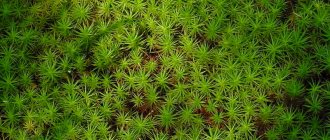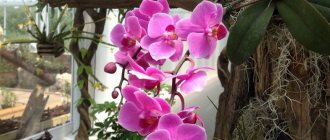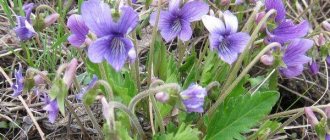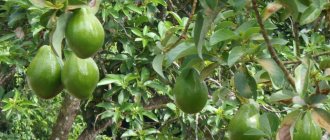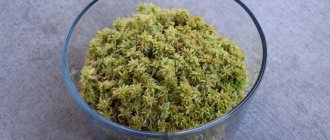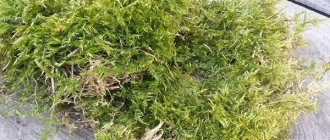- November 24, 2018
- Wild plants
- Michael
Probably, many readers have heard about such moss as sphagnum. It is not surprising - it is found in many regions of our country and is actively stocked by experienced flower growers. And in general, the scope of its application is quite wide. Therefore, it will be useful to tell you how sphagnum moss is used and where it grows. The photos attached to the article will allow you to learn more about him.
Appearance
Now it’s worth telling what sphagnum moss looks like - the photos still give only a fairly superficial idea.
He cannot boast of a particularly outstanding appearance. It has a very thin green stem that starts at the root and stretches upward. It is distinguished by its emerald green color. The upper part is covered with small leaves arranged in a spiral. By the way, for the sake of clarity, it should be noted that this moss actually has no roots. And that brown part, which not very experienced botanists perceive as a root, is an old, dead part of the plant.
Sphagnum, despite its small size, is a perennial plant. As cold weather approaches, it freezes to continue life in the spring. It only grows upward, not sideways. The lower part dies over time, rots, becoming peat.
The stems grow very densely, most often in damp places. Because of this, only the upper part receives the light necessary for the development of green plants. And in the lower, shaded area, chlorophyll is destroyed over time, and it becomes white. Over time it rots, turning brown.
It reproduces, like most mosses, with the help of spores. They contain germ cells grown on the stem. After ripening, the sac bursts, and thanks to water and wind, light spores are carried over a considerable distance.
Botanical description
Sphagnum belongs to the genus of bog mosses and has another name - Peat moss. It is sphagnum that, in the process of life, forms layers of this valuable, widely known material. Such moss has no roots, and its stems grow strictly vertically, without expanding in breadth. The lower part gradually dies off, forming layers of peat.
The greatest diversity of mosses is found in the northern hemisphere. There are about 40 species of sphagnum in Russia. Soft, vast glades of moss are found in damp, shady forests, swamps, and floodplains. Sphagnum often appears in temporarily flooded areas.
Erect, thin stems of moss stretch upward, are highly branched and can exceed 20 cm. The shoots are soft green and watery. Some of them are directed to the sides and upwards, the other part hangs along the central stem.
Sphagnum shoots are densely leafy in the upper part. Small translucent plates-scales most often grow in a spiral. Toward the top, the stems have fluffy crowns of tufts of branches. Spores ripen in small boxes on short stalks. The opening of the capsules and the dispersal of spores occurs towards the end of summer.
Sphagnum moss also grows in swamps; it is easy to distinguish from other species. The lower part of the plant consists of whitish, drying stems that cake, turn brown and form peat.
If the sphagnum moss is pulled by the green tops, they are separated from the dried layers without effort, whereas the common Cuckoo moss has rhizoid roots, and the upper part cannot be easily separated.
Despite the tenderness of its watery stems, sphagnum is a perennial. The tops killed by frost grow back in the spring.
Sphagnum has the ability to absorb moisture over its entire surface. The unique structure of the plant allows it to absorb and retain 20 times more liquid than its weight.
Characteristics of sphagnum moss.
Hollow, water-storing cells have rigid walls and do not participate in photosynthesis and plant nutrition. For this they are called dead. They are surrounded by smaller, green ones that produce chlorophyll. The cellular structure of moss has a pronounced mesh structure. Sphagnum practically does not rot and forms 1–2 mm of peat every year.
Where is it found?
Now it’s worth telling how to find sphagnum moss in nature - photos will help you easily identify it.
This valuable plant is most often found in the north of our country. Moreover, mainly in forest thickets, where high soil moisture is provided by small rivers and lakes, as well as streams and swamps.
Sphagnum is surprisingly unpretentious. Even weak, diffused sunlight is enough for it to develop successfully. In addition, it grows well on all surfaces: stones, clay, trees, earth, even glass and iron.
However, if we tell you where sphagnum moss grows in Russia, a photo of which is attached to the article, then it is worth noting that it can also be found in the steppe. But this place should be very wet - for example, somewhere near streams or lakes.
Properties
Sphagnum moss (grows on the banks of streams) is a valuable natural material that previously had a very wide range of uses. They were used to lay joints during the construction of houses, barns, and baths. Water was filtered through fresh moss. The plant was applied to festering or open wounds to treat infections.
Today, moss is not used as actively, but scientists continue to study its unique properties, creating artificial materials that replicate the qualities of sphagnum. Simple bog moss has three main characteristics.
Hygroscopicity
The name Sphagnum is translated from Greek as “sponge”. The ability of moss to absorb and retain moisture, which gave it its botanical name, is unique. The plant absorbs an amount of water 20–25 times its mass. At the same time, the moss has excellent aeration. By passing dry air through itself, sphagnum moisturizes it. If the atmosphere is oversaturated with moisture, moss absorbs the excess.
Breathability
The ability to maintain a loose structure without overheating makes sphagnum moss one of the best means for loosening the soil. This filler provides breathing to the roots and makes any substrate lighter.
When growing exotic plants in conditions unusual for them, sphagnum provides not only looseness of the substrate, but also constant high humidity of the soil and air. The cells of peat moss contain not only water, but also air bubbles, which allows the roots to breathe even when the soil is completely flooded.
Even with maximum moisture, sphagnum does not cake or clump. Excess water quickly leaves through the loose substrate, and the supply of atmospheric air is resumed. Moss added to the soil will prevent it from silting or forming a continuous, airtight layer.
Antibacterial
Sphagnum has a complex chemical composition, but contains virtually no nutrients. In combination with carbolic acid (an antibacterial substance), this provides a powerful disinfectant effect. Sphagnum is practically not subject to rotting itself, and also disinfects the environment.
Modern scientists attribute part of the antibacterial effects of the plant to the activity of special endophytic bacteria that live in close symbiosis with marsh plants. Therefore, fresh moss exhibits powerful disinfectant properties and loses some of them when drying.
In the absence of dressings, sphagnum moss replaces bandages, cotton wool and disinfectants. A piece of a fresh plant applied to a wound quickly disinfects even heavily contaminated tissue, stops bleeding, promotes rapid healing, and relieves pain.
During the Second World War, sphagnum harvesting was carried out purposefully. The material was sent to the front to provide first aid on the battlefield. USSR scientists developed the biogenic stimulant Peat, which was successfully used for arthritis, myalgia, and eye diseases.
Today in Russia, official medicine does not use sphagnum.
In everyday life, peat moss is still used to treat fungal skin infections, dermatitis, and abrasions. Decoctions or extracts from the plant are effective against staphylococci and have a bactericidal and bacteriostatic effect on the pathogenic environment of purulent wounds.
How it is used
Not every person who has seen a luxurious sphagnum carpet in the forest realizes how wide the scope of this amazing plant is. But people have learned to use it in construction, crop production, cosmetology and even medicine.
Thanks to a number of features, moss becomes a truly unique material. To begin with, it should be noted that it perfectly allows air to pass through, absorbing excess moisture from it, and dry, on the contrary, moisturizes to a comfortable level. Experts say that moss absorbs a huge amount of moisture - 20 times more volume than it has itself! Can any other material boast such an indicator of moisture absorption?
It is also very important that it has antiseptic properties. This allows it to be used in medicine, mainly in extreme medicine.
However, in order for the reader to better understand the topic, it is worth giving a few specific examples.
What does sphagnum moss look like and where does it grow?
The marsh plant of the Sphagnum family thrives in conditions that are destructive for other representatives of the flora. It grows on almost any surface:
- stone;
- glass;
- metal;
- tree trunks.
Moss has a branched stem, with small leaves arranged in a spiral along it and along the branches. Sphagnum absorbs moisture in a volume that is several tens of times greater than its own.
Moss grows in deciduous forests, along the banks of rivers and streams, and in swamps. Most often, it settles under aspen trees in soil depressions and begins to grow after the snow melts in places where pools of water remain. During the winter, sphagnum freezes, but is quickly restored in the spring.
Why do flower growers need it?
Most often, when talking about the use of sphagnum moss, a photo of which is attached to the article, people remember indoor plants. It is really actively used in caring for flowers.
First of all, it’s worth talking about help with seed germination. They need to be kept in a humid environment. However, fabric, not to mention paper, dries very quickly. You have to moisturize it every day, and sometimes several times a day. Sphagnum moss solves this problem - moisten it generously and wrap the seeds in lush greens. After that, you can forget about them for several days. The moss will quickly absorb excess moisture, so rot does not threaten the seeds. But then it will give them excess moisture and they will not dry out.
Due to this same effect, moss is actively used when caring for plants in pots. You need to lay a thick layer of sphagnum directly on the soil, after which you can water the flowers not daily, but once a week. At the same time, moss will protect plants from bacteria and infections that carry diseases. It has long been noted that sphagnum, which has antiseptic properties, does not allow the appearance of mold and fungi in its vicinity.
In addition, the soil underneath becomes looser and softer. As a result, it is better saturated with oxygen, and the plant grows faster.
In addition, with the active growth of moss, its lower part will die off, this has already been mentioned above. As a result, dead areas turn into peat - an excellent fertilizer for any plant.
Methods of use
There are different ways to use it, here are a few of them:
Adding to Soil
As already mentioned, sphagnum makes the soil loose, light and regulates moisture. You need to know some rules of use: white moss in the soil should be no more than 10 percent, since the plant increases the acidity of the soil. But you should also remember that, for example, it will be very useful for violets.
Use for tubers and bulbs
White moss can be used to wrap tubers and bulbs of heat-loving plants. This will protect them from rotting and drying out for a long time. Flowers will survive until spring planting, because they will not be afraid of gray rot and mold.
Lining the pot
Lining a flower pot with sphagnum moss is usually used for flowers that require high humidity. Moss retains moisture in the soil well, and some of the water evaporates, giving moisture to the crown, which also has a good effect on the plant. However, this method should not be used for ordinary flowers; too much moisture can harm them. But, for example, when planning a trip for a week, moss can be very useful. By covering the soil and watering the flower, the moisture will remain in it for another 7-10 days.
Rooting cuttings and leaves
Rooting with the addition of sphagnum moss to the soil (1:1) prevents rotting of cuttings and leaves. Then, when transplanting, moss is used in a ratio of 1:3. This method is most often used when it comes to orchids and violets. On the contrary, this method will not work for succulents.
Application in medicine
Historians are well aware that during terrible wars like the Great Patriotic War, sphagnum saved the lives and health of many soldiers and officers. There was a catastrophic shortage of simple antibiotics, bandages and cotton wool, so experienced doctors used sphagnum moss. Clean bundles were placed directly on the wound, after which they were rewound with any fabric, often not even sterile. Sphagnum destroyed harmful bacteria around it. Thanks to this, the wounds healed faster. It is no coincidence that earlier detachments were formed from pioneers and Octobrists, which prepared this raw material and sent it to the front.
It can also be used at home. Do you suffer from nail or foot fungus? Put some moss in your shoes and solve this problem forever. Moreover, without purchasing expensive drugs with questionable effectiveness.
You can take baths with sphagnum moss. Steam 100 grams of moss with three liters of boiling water, leave overnight and pour into a bathtub filled with warm water. Two half-hour procedures a week (just lie in the bath) and arthritis and arthrosis will recede, sweating will improve and excess salt will be removed from the body.
For rooting sprouts
Sphagnum moss is suitable for rooting cuttings, leaves and air layering of all types of houseplants, except succulents.
When using moss for this purpose, it is necessary to mix it with the soil in equal proportions.
- Drainage is placed at the bottom of the planting container, then a moistened mixture of sphagnum and soil is laid out.
- Prepared cuttings or leaves are placed in it.
- Afterwards, the container is covered with a transparent lid or film. Moss must be moistened periodically. You can use wick irrigation for this.
It is very convenient to carry out rooting in a plastic bottle cut into two parts.
After the roots have formed, the young plants need to be transplanted into separate pots filled with a mixture consisting of 3 parts soil and 1 part moss.
Growing moss
Not everyone knows that sphagnum can be cultivated at home, and the procedure is surprisingly simple. It is enough to have at least a small piece of moss - you can find it in the forest, take it from friends or purchase it in a special store.
First, the sphagnum moss needs to be washed. To do this, soak it in warm water (preferably settled) and leave for half a day. Every few hours the moss needs to be lightly shaken to remove debris, soil and sand. After the time has passed, carefully remove the thin stems and pour out the dirty water.
Now you can start growing the plant. Place it in a three-liter jar or small aquarium. Pour some water, close the container and leave in a sunny place. During photosynthesis, oxygen will be produced, and dead stems will serve as a substrate and source of carbon dioxide. This will create a closed ecosystem from which you can sometimes take some of the moss and add a little water.
For germinating seeds
Often gardeners fail to germinate seeds that are too small. This is due to the fact that they cannot be covered with soil, and such seed material dries out quickly on the surface. If you water the seeds too much, they will simply rot.
Germination in sphagnum will give a completely different effect. Due to its hygroscopicity, moss retains moisture for a long time , so seeds planted in it will definitely sprout.
The main thing is to cover the container with plastic wrap after sowing.
Harvesting sphagnum
If you find a variety of sphagnum moss in the forest (photos will help you identify it), then you can stock it for future use. It is best to collect valuable raw materials near streams or lakes in well-shaded places - these are ideal conditions, which means the plant will be of the highest quality.
You can collect all the moss along with the “roots”, then the process goes much faster. In addition, peat fertilizer will form faster, which is important for many gardeners.
Or you can carefully cut off the top green layer using simple scissors, leaving the white and brown in place. In this case, you will get a smaller volume of moss, but it will be alive and will be able to grow perfectly, quickly increasing in your small plantation.
Collection and storage
Harvesting of sphagnum moss occurs from April to October. But there are some nuances here too. For example, collection in early spring may be complicated by the presence of melt water in areas where moss grows, and in July by blood-sucking insects. Rainy October can also ruin all plans. Therefore, the best time, according to experts, is August or September. Especially if the weather is suitable - dry and warm.
Moss is collected in two ways:
- extracted completely, even the root - get a larger quantity, but be prepared to spend time on thorough cleaning;
- the upper part is cut off with a knife - the mass is smaller, but the moss is cleaner.
When going for sphagnum moss, you must have rubber boots, gloves and plastic bags. Just in case, you can take a bactericidal patch with you, since cuts on your hands are possible when working with a knife.
Freshly collected sphagnum moss without roots.
If you need live moss, it is better to place it in the shade, spreading it evenly over the surface. Let the wind dry the sphagnum a little - it should be moist, but not wet! In order for all the beneficial properties to be preserved, moss should be stored in plastic bags in a cold room, even in the cold. When needed, they bring it into a warm room and it comes to life.
Sphagnum moss also grows at home. To grow it yourself, you need to cut off the green part and place it in a tray with wet peat. Be sure to water daily.
We store it correctly
The rules for storing moss depend primarily on how you plan to use it.
Do you need dry sphagnum moss used in medicine? Then the easiest way is to use a cord or strong thread and hang the stems in a thin layer in a warm place with good ventilation. Well, or at least spread it out on a towel or newspaper and leave it on a windowsill well lit by the sun. Stir the moss a couple of times a day to ensure it dries evenly. Otherwise, the top will dry out and form a crust. Inside, the stems will remain damp and over time, mold may appear here, making the use of moss for medical purposes impossible.
A completely different storage method should be chosen if your goal is to keep it alive for the longest possible period. Coping with this task is not at all difficult. Rinse the moss well, then place it in a paper or cloth bag and place it in the refrigerator or freezer. In such conditions, it can easily be preserved for several years. When you need sphagnum moss, simply remove it from the refrigerator and leave it in a warm, slightly humid place. After a few hours, the stems will thaw, and after a few days they will continue to grow as if nothing had happened. But here it is worth considering that the longer the sphagnum lies frozen, the fewer stems will remain alive. It is advisable to remove the rest as soon as it becomes clear that they are dead. This is not difficult to determine - they dry out quite quickly.
Taking care of snails
Sphagnum is also well known to many lovers of land snails. Moreover, it allows you to solve a whole range of problems at once. And this despite the fact that the question of how to use sphagnum moss for snails does not even arise: just put a bunch in a terrarium with sufficient humidity, and you can forget about it.
The moss will grow quickly and maintain an optimal level of humidity. Sphagnum is also quite attractive: the rich green stems enliven the terrarium and make it more beautiful.
Snails rarely suffer from infectious diseases. But if they live in a terrarium with moss, then the likelihood of disease is completely excluded - an additional plus for snail lovers.
In addition, moss can serve as an excellent addition to your pets' diet. Under suitable conditions, it grows quickly, and no matter how quickly the snails eat it, they will not cause serious harm, not to mention the complete destruction of a kind of living lawn.
At the same time, it allows you to monitor the humidity level, playing the role of a kind of indicator. If the stems are green, everything is fine. But if the leaves begin to turn yellow, it means that the air in the terrarium is very dry, it is worth adding a little water so that both the moss and the snails feel quite comfortable.
